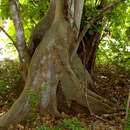Description
provided by Flora of Zimbabwe
Large tree, often with a well buttressed trunk. Bark smooth, pale brown; stem and branches often with conspicuous pale lenticels. Leaves oblong 5-17 cm, glossy green, obscurely 3-veined from the base; margin entire in the basal half, coarsely and irregularly toothed in the apical half; base slightly asymmetrical. Flowers in small axillary clusters, greenish. Fruit c. 1.2 cm, fleshy, red, tipped with the remains of the stigma.
- license
- cc-by-nc
- copyright
- Mark Hyde, Bart Wursten and Petra Ballings
- bibliographic citation
- Hyde, M.A., Wursten, B.T. and Ballings, P. (2002-2014). Celtis mildbraedii Engl. Flora of Zimbabwe website. Accessed 28 August 2014 at http://www.zimbabweflora.co.zw/speciesdata/species.php?species_id=120080
- author
- Mark Hyde
- author
- Bart Wursten
- author
- Petra Ballings
Frequency
provided by Flora of Zimbabwe
Rare (Chirinda Forest only in Zimbabwe) but common there
- license
- cc-by-nc
- copyright
- Mark Hyde, Bart Wursten and Petra Ballings
- bibliographic citation
- Hyde, M.A., Wursten, B.T. and Ballings, P. (2002-2014). Celtis mildbraedii Engl. Flora of Zimbabwe website. Accessed 28 August 2014 at http://www.zimbabweflora.co.zw/speciesdata/species.php?species_id=120080
- author
- Mark Hyde
- author
- Bart Wursten
- author
- Petra Ballings
Insects whose larvae eat this plant species
provided by Flora of Zimbabwe
Libythea labdaca laius (African snout)
- license
- cc-by-nc
- copyright
- Mark Hyde, Bart Wursten and Petra Ballings
- bibliographic citation
- Hyde, M.A., Wursten, B.T. and Ballings, P. (2002-2014). Celtis mildbraedii Engl. Flora of Zimbabwe website. Accessed 28 August 2014 at http://www.zimbabweflora.co.zw/speciesdata/species.php?species_id=120080
- author
- Mark Hyde
- author
- Bart Wursten
- author
- Petra Ballings
Worldwide distribution
provided by Flora of Zimbabwe
West Africa to Sudan, DRC, Angola, Tanzania, Mozambique, Zimbabwe and KwaZulu-Natal, S Africa
- license
- cc-by-nc
- copyright
- Mark Hyde, Bart Wursten and Petra Ballings
- bibliographic citation
- Hyde, M.A., Wursten, B.T. and Ballings, P. (2002-2014). Celtis mildbraedii Engl. Flora of Zimbabwe website. Accessed 28 August 2014 at http://www.zimbabweflora.co.zw/speciesdata/species.php?species_id=120080
- author
- Mark Hyde
- author
- Bart Wursten
- author
- Petra Ballings
Comprehensive Description
provided by Smithsonian Contributions to Botany
Celtis mildbraedii Engler
(Syn. C. soyansii Engler)
Standard trade name: Celtis
Local name: Esa-fufuo
A common mixed deciduous forest tree growing up to 120 ft high and up to 10 ft in girth. The leaves are up to 7 × 3 in long, acuminate, elliptic obovate, stipulate, coarsely toothed, especially towards the apex, rarely entire. The flowers are minute, axillary, greenish white, rusty pubescent.
GENERAL DESCRIPTIONS.—The wood weighs 45–50 lb/ft3 seasoned and averages about 49 lb/ft3; it is hard and medium heavy. High luster, fine texture and interlocked grain, although sometimes straight. Celtis species have whitish or light yellow color when green, becoming grayish white later.
SEASONING.—Celtis can be kiln seasoned fairly rapidly from the green condition with little degrade.
DURABILITY.—Celtis is not durable. It is susceptible to severe damage by ambrosia and powder-post beetles. In preservative treatment the sapwood is said to be permeable while the heartwood is moderately resistant.
WORKING QUALITIES.—With machine tools celtis works well, but it is hard to work with hand tools as it dulls the cutting edges moderately. It finishes well without requiring special treatment. It peels satisfactorily and glues well, but nailing may split it. Preboring may be necessary.
USES.—Celtis can be used for flooring and telegraph poles (treated). It is used for house posts, sports gear, and also locally (in Ghana) for fufu pestles. It has good strength properties and should be a useful substitute for ash. It is a good substitute for maple for dance floors (FPRL, 1956). It is used for furniture framing, commercial plywood, and light colored veneer.
XYLEM ANATOMY.—Growth rings variable (?). Wood diffuse-porous. Vessels: in 2’s and 3’s, but range from 1 to 7; generally circular; average pore diameter 59μm, range 50μm–70μm; average vessel element length 399μm, range 288μm–538μm; vessel wall thickness undetermined; perforation plates simple; vessel element end wali inclination oblique to transverse; intervascular pitting alternate. Imperforate tracheary elements: nonseptate fiber tracheids, average length 1346μm, range 1063μm–1563μm; fibers with no pits. Vascular rays: homogeneous, multiseriate (triseriate), generally 3 cells wide, 6 to 25 cells high, but uniseriate and biseriate present; no fusiform rays; no intercellular canals. Axial parenchyma: paratracheal, scanty with no amorphous deposits, apotracheal, abundant. Crystals: not present.
- bibliographic citation
- Ayensu, Edward S. and Bentum, Albert. 1974. "Commercial Timbers of West Africa." Smithsonian Contributions to Botany. 1-69. https://doi.org/10.5479/si.0081024X.14
Celtis mildbraedii: Brief Summary
provided by wikipedia EN
Celtis mildbraedii is a species of forest tree in the family Cannabaceae. It was previously assigned to the family Ulmaceae. These trees grow in limited areas of South Africa, Mozambique and Zimbabwe. They are also found in forested areas from West Africa to Sudan, DRC, Angola and Tanzania. Common names include natal white stinkwood, red-fruited white-stinkwood and natal elm. This species is more common in Tropical Africa than in Southern Africa.
There are about forty specimens in Pigeon Valley Natural Heritage Park, Durban, South Africa. The southernmost specimen is found in Ilanda Wilds Nature Reserve in Amanzimtoti.
The fruit of the tree turns red as it ripens but viable seed is difficult to find. No Natal White Stinkwoods were available from plant nurseries in South Africa in 2009 suggesting that this tree species is not being propagated, despite its rarity in South Africa.
This tree is a dominant species in the moist semi-deciduous forests of Ghana along with Triplochiton scleroxylon and African Mahogany (Khaya ivorensis). The trees were common in Ajenjua Bepo and Mamang River Forest Reserves in Ghana.
In Uganda the tree is used for timber and is a primate food source in Budongo Forest Reserve. A study of correlations between seedling and adult tree densities of Celtis mildbraedii here, suggested that this species had a healthy regeneration pattern.
- license
- cc-by-sa-3.0
- copyright
- Wikipedia authors and editors

